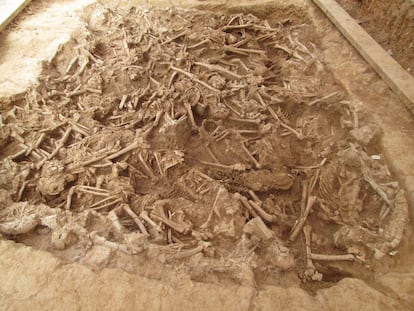How a virus helped a woman survive a dangerous antibiotic-resistant infection
Doctors in Belgium explain how they saved a bomb attack victim who had been struggling with one of the most virulent bacterial pathogens in the world

On March 22, 2016, a 30-year-old Belgian woman was in Brussels airport when a bomb exploded just a few meters away. It was a terrorist attack by Islamic State (ISIS). A total of 35 people were killed, including the three perpetrators. Now, six years on, the startling story of how her life was saved has been published in the science journal Nature Communications. The woman owes her life to an experimental treatment that used a virus to heal an antibiotic-resistant bacterial infection, a global health problem that kills more than one million people worldwide every year.
After the bombing, the victim was transferred to the emergency department of Erasmo Hospital in the Belgian capital. Her heart had stopped beating, but doctors were able to revive her. They amputated part of her hip and carried out emergency surgery to save her leg. Four days later, just when her situation seemed to have stabilized, the real nightmare began: a bacteria called Klebsiella pneumoniae had infected her left thigh and was not responding to treatment from any existing antibiotics. The doctors realized that the microbe could pose a greater threat to her life than the bomb that had nearly killed her.
The bacteria that had infected the 30-year-old patient belonged to ESKAPE, an acronym for six of the most dangerous antibiotic-resistant bacterial pathogens, according to the definition from the World Health Organization (WHO). These microorganisms represent one of the biggest threats to global health. The WHO estimates that these bacterial infections, which typically spread among hospitalized patients, will kill 10 million people a year by 2050. That’s three times as many fatalities officially caused by Covid-19 in 2020.
“I was on duty in the intensive care unit when this patient arrived and I was responsible for her for three years, two for treatment and one for rehab,” says Anaïs Eskenazi, the patient’s doctor and the lead author on the study of her recovery. The story is chilling: five operations, including one to remove part of the stomach and spleen, autologous bone grafts, and then an infection that remained for four months as it resisted treatment with all existing antibiotics.
After months of doubt, the medical team decided to turn to an experimental treatment that is usually only adopted as a last resource: using a virus specialized in killing bacteria to fight the infection. But first, they had to find the best virus to take on the bacteria, no simple feat given that bacteriophage, known informally as phages, are the most numerous organisms on Earth.
“These viruses are everywhere, in the intestine, in the throat, on the skin; there are 10 times more phages than bacteria,” explains Jean-Paul Pirnay, a molecular biologist at Queen Astrid Military Hospital in Belgium. Pirnay leads one of Europe’s most advanced groups on the use of these phages to fight bacterial infections that are impossible to defeat with just antibiotics. To find the right virus for the patient, Pirnay went to the Eliava Institute in Georgia, which has been using phages to treat bacterial infections for more than a century. According to Pirnay, this is a legacy from the days of the Soviet Union, where the technique flourished in the Second World War, in particular during bloody battles such as the Battle of Stalingrad.
Generally in Europe, except in countries in the east, the use of phages in clinics is not regulated. Specific legislation is needed in order to be able to use them routinelyPilar Domingo Calap, Institute for Integrative Systems Biology
The medical team analyzed the genome of the bacteria that had infected the 30-year-old and began to look for a phage capable of killing it. They found it in a sewage water sample. Once the virus was prepared for the therapy it was administered directly to the affected area of the patient.
The combined treatment of phages and antibiotics completely eradicated the bacterial infection, the medical team explain in the article, published in Nature Communications on January 18. Three years after the treatment, the patient can now walk again with the help of crutches and is even taking part in sports events.
“This is one of the most promising treatments against [antibiotic] resistant bacteria,” says Eskenazi. These microbes tend to build up in fine layers on surgical instruments or on medical devices, such as a stent or the external fixator placed on the patient’s broken bones. “A team from Leiden University in the Netherlands created these same biofilms in the laboratory and showed that a combined treatment of phages and antibiotics eliminated the infection much better than each treatment on its own,” adds Eskenazi.
Part of the treatment’s success is due to the “training of the phages,” says Pirnay. This involves directing the evolution of these viruses by growing one generation after the other alongside the bacteria that is infecting the patient. In each generation, the virus that kills the most bacteria is selected and moves to the next round. The result is an elite force of phages specially adapted to fight a specific pathogen. “Phages are harmless to people because we have been evolving alongside them for millions of years. The only difficulty of this type of therapy is its specificity. For each bacteria, you have to find the phage that is able to fight it,” explains Pirnay.
In recent years, Pirnay’s team has used phages to treat more than 100 patients in 12 countries, including one in the Virgen de la Macarena Hospital in Seville, in southern Spain. The patient was a 58-year-old man who had been suffering for a year from a blood infection caused by Pseudomonas aeruginosa, another bacteria in the ESKAPE group of dangerous bacterial pathogens.
The doctors asked Pirnay to prepare the phages, which were then applied to the patient, who overcame the infection, explains María del Mar Tomás, a phage expert at the University Hospital in A Coruña in Spain’s northwestern Galicia region. “Phages are able to stop the bacteria from being resistant to antibiotics,” she says. “The bacteriophages attack the same molecular targets that bacterias use to avoid the effect of antibiotics. If you administer phages first, then antibiotics, you block their resistance and the infection subsides.”
Pilar Domingo Calap is a phage hunter. “We find them everywhere: wastewater, irrigation ditches, in the ground, even on plants in city centers,” says the microbiologist from the Institute for Integrative Systems Biology in Valencia, in eastern Spain. Her lab has found more than 200 types of phages capable of fighting K. pneumoniae. Domingo Calap explains her lab is also working to help a small group of patients with bacterial infections, such as a young man with cystic fibrosis who is waiting for a double lung transplant and suffers from an ongoing antibiotic-resistant bacterial infection.
This kind of treatment is just taking its first steps and its widespread application is complicated, says Domingo Calap. “Generally in Europe, except in countries in the east, the use of phages in clinics is not regulated. Specific legislation is needed in order to be able to use them routinely. In France and Belgium, the government is investing in these experimental treatments, although there is still a long way to go before they are regulated,” she explains. “Spain only allows them to be used as compassionate treatment. From the Spanish Bacteriophage Network, we are trying to get the Medicines Agency to allow us to regulate their use.”









































